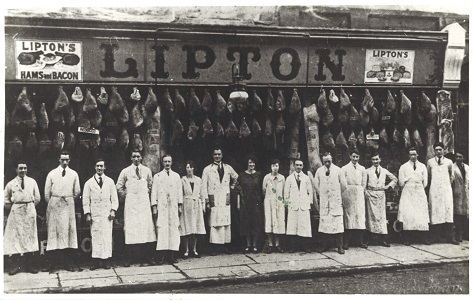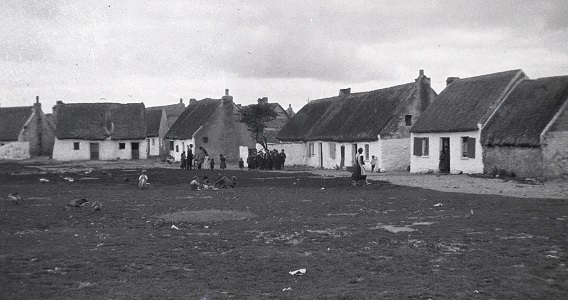Old Galway
Kirwan’s Lane c.1965

by Tom Kenny
In spite of the sunshine, this is a dreary 1960’s photograph of Kirwan’s Lane which was originally taken by Derek Biddulph.
There were fourteen medieval lanes in Galway and this is one of only five that still exist. It was originally two lanes, separated by a building which blocked the street. On the 1651 map, the section in our photograph was known as “Vicus Kirvanorum” while the other section that ran towards Quay Street was “Vicus Mole Martini”, Martin’s Mill Lane.
Selling on the Prom

by Tom Kenny
The first people to sell produce along the Promenade were women who carried buckets of cockles and mussels and sold them to tourists. They would sit on the concrete seats and announce their wares. I don’t know if they sang “Alive alive oh” in a Galway accent or not.
Later, stalls would appear parked on the roadside which sold Salthill rock, Peggy’s Leg, and sweets, and sometimes small items marked “A souvenir from Salthill”.
SAINT ANTHONY’S COLLEGE

by Tom Kenny
The Franciscans first came to Galway in 1296 and founded “The Abbey”. In 1483, a school of advanced theology was instituted there. When the Cromwellians invaded the city, the friars were expelled. In 1657, their friary was destroyed and the church was turned into a courthouse – the present courthouse stands on the same site. In 1660, a new church was erected on the present site of the Abbey. There were 13 friars there in 1766 and 8 years later, a novitiate was opened here. The present friary was built or rebuilt in 1820, and the present church opened c.1836. It was renovated in the 1970’s and became the first Franciscan parish in 1971.
“98’s”, UNDER-16 STREET LEAGUE CHAMPIONS, 1968

by Tom Kenny
In 1893, a Bohermore hurling club was affiliated to the County Board. There was a strong nationalist tradition in the area and so the club evolved into Bohermore 98’s in honour of the centenary of the 1798 rebellion. The guiding lights of the club were Jim Tonery, Paddy ‘Ham’ Ruffle and John Crowe. The club forfeited a County Championship in 1903 when one of their players was sent off. The team protested at the injustice of the decision and walked off the pitch. Their clubhouse was in Bohermore on a site that was later occupied by “Monto’s Shop” and is today covered with townhouses.
FAIR DAY, EYRE SQUARE, SEPTEMEBER 2ND, 1926

by Tom Kenny
This photograph of a cattle fair on Eyre Square was taken looking toward the west. The buildings in the distance were, on the far left, Gilbeys who were drinks distributors and who later moved premises to William Street; Next to them was Webb’s Hotel. This was originally built in 1810 and was known as the Clanricarde Arms. It was later known as Kilroy’s Hotel, then Murphy’s until it was taken over by Joe Delaney and he changed the name to The Imperial Hotel.
LIPTONS IN GALWAY

by Tom Kenny
In 1871, Thomas Lipton from Glasgow used his savings to open his first shop. By the 1880’s he had over 200 shops. He was an entrepreneur, and when he realised that there was potential for growth in the market for tea, and that the product was too expensive, he went to Ceylon and bought his own tea plantation. He sold his tea at low prices in one pound packets, half and quarter pound packets and he advertised it very cleverly, “Direct from the Tea Gardens to the Teapot” or “Treat your Lips to a Cup Of Lipton’s Peko Tips Tea, two shillings and eight pence per pound”.
STOP! THIS IS THE BAL

by Tom Kenny
This pub was one of Salthill’s landmarks for over a century. It was a post office originally until Joe Crehan from Ballinasloe bought it at the end of the 19th century and converted it into a pub, grocery and guest house. The name Ballinasloe House was quickly shortened in Salthill to ‘The Bal’. At the time Salthill village ran from here to Seapoint with a few houses further west.
THE ‘GREEN GRASS’ IN THE CLADDAGH

by Tom Kenny
This photograph of ‘The Green Grass’ also known as ‘The Big Grass’ in the Claddagh was taken on the 29th of July 1914. It was taken from roughly where the Claddagh Hall is today. There was a wide expanse of grass off to the left towards where South Park is today. In the early days parts of it were tidal, the tide would come in here in the form of a series of streams. In Peadar O’Dowd’s wonderful book on the Claddagh, there is an image of this area with a very large stream in the foreground. These streams were gradually filled in, thus creating the kind of surface we see in the photograph. There were occasional sandy patches visible on the grass.
.png)